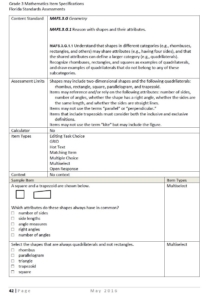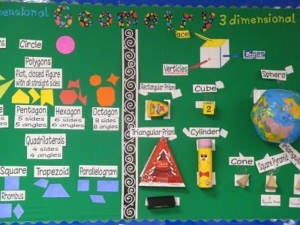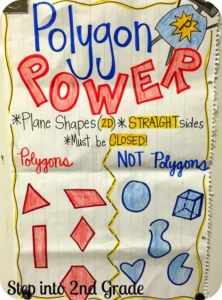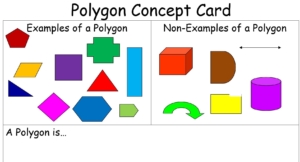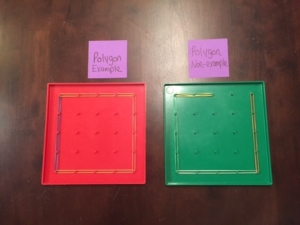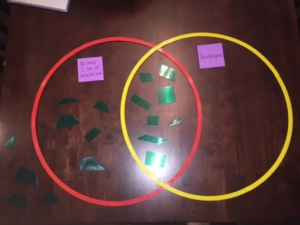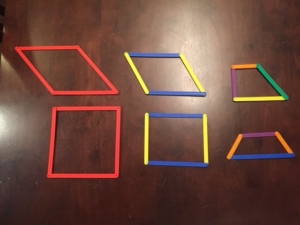Here are the top 5 things you need to consider when teaching or revisiting Geometry concepts in 3rd grade.
1. What is included in the Geometry domain for 3rd grade?
• Understand that shapes in different categories may share attributes. For example: rhombuses and rectangles share the attribute of 4 sides.
• Shared attributes can define a larger category. For example: Because rhombuses and rectangles share the attribute of 4 sides that are in the quadrilateral category.
• Recognize shapes that are defined as quadrilaterals. Shapes include: parallelogram, rhombus, rectangle, square and trapezoid.
• Define shapes using the following attributes: number of sides, number of angles, whether the shape has a right angle, whether the sides are the same length, and whether the sides are straight lines. (Note – it is not required that students identify acute and obtuse angles within the shapes. It is also not required to use the language parallel or perpendicular at this time).
2. Develop Vocabulary – Vocabulary should be developed through exploration and discovery. Here are some things to implement in your classroom to develop vocabulary understanding of Geometry:
• Word Walls – put the attributes and names of shapes on the word wall with specific examples and even better – kid work!
• Anchor Charts – group the vocabulary by category. For example: could have an anchor chart for types and names of quadrilaterals, one for polygon/non-polygon and another one for attributes of polygons.
• Concept Cards – created by posing examples and non-examples of what you are defining. From the examples and non-examples, students determine a definition for the topic. This can be used for any geometry vocabulary word.
• Shape Riddles – Spiral practice of the concepts by posing a shape riddle for students to solve with vocabulary attributes. This can be done during the unit and after the unit. It may also include multiple answers to prepare for students for multi-select questions. Students can also be asked to create their own shape riddle and trade with a partner to solve. For example: “I have at least 2 sets of congruent, parallel sides. What shape am I?” Answers: Parallelogram, Rectangle, Rhombus, Square.
3. Identifying, Naming and Describing Shapes – It’s important for students to explore attributes of shapes to identify their similarities and differences. From there, they will name and describe how they know the shape has the name it does. In 3rd grade, this is limited to polygon/non-polygon, and quadrilaterals.
4. Make Geometric concepts relevant and ongoing
• Continue to make connections to the real world by having students discuss the shapes around them. Continue to be precise with geometric language, for example: When having students sit on the carpet, have them sit on the rectangular carpet then challenge them to name it every other name it could be based on its attributes. Also consider this activity: Have students go on a shape scavenger hunt throughout the school or at home to look for the different quadrilaterals after you learn about them.
• Discussions of geometric concepts should not end after the unit is complete. Continue to keep the words from the geometry unit up on the word wall and refer to them throughout the year.
5. Tools to use to teach Geometry
• Geoboards – Used to create different polygons and non-polygons. Consider this activity: Create a concept card with a few examples and non-examples of polygons. Have students create an example of a polygon or a non-example on their geobard and explain how they know it fits either category.
• Venn Diagrams – Used to compare and contrast attributes of polygons or quadrilaterals. Consider this activity: Give the students a triple venn diagram and the attribute labels of polygon, quadrilateral, right angles. Have students sort their shapes into the sections and explain why they were placed where they are.
• Power of Polygon Shapes – Used to compare, contrast, name and identify different quadrilaterals and polygons. Consider this activity: Using in conjunction with Venn Diagrams to compare and contrast based on attributes. (Note – there is a paper copy of these located on the GCG).
• AngLegs – These can be found in most schools, ETA Hand 2 mind or even on Amazon. Used to create, explore and understand attributes of polygons.
For more information on teaching Geometry in 3rd grade, read the article from NCTM, “Teaching Young Children About Geometric Shapes.”
